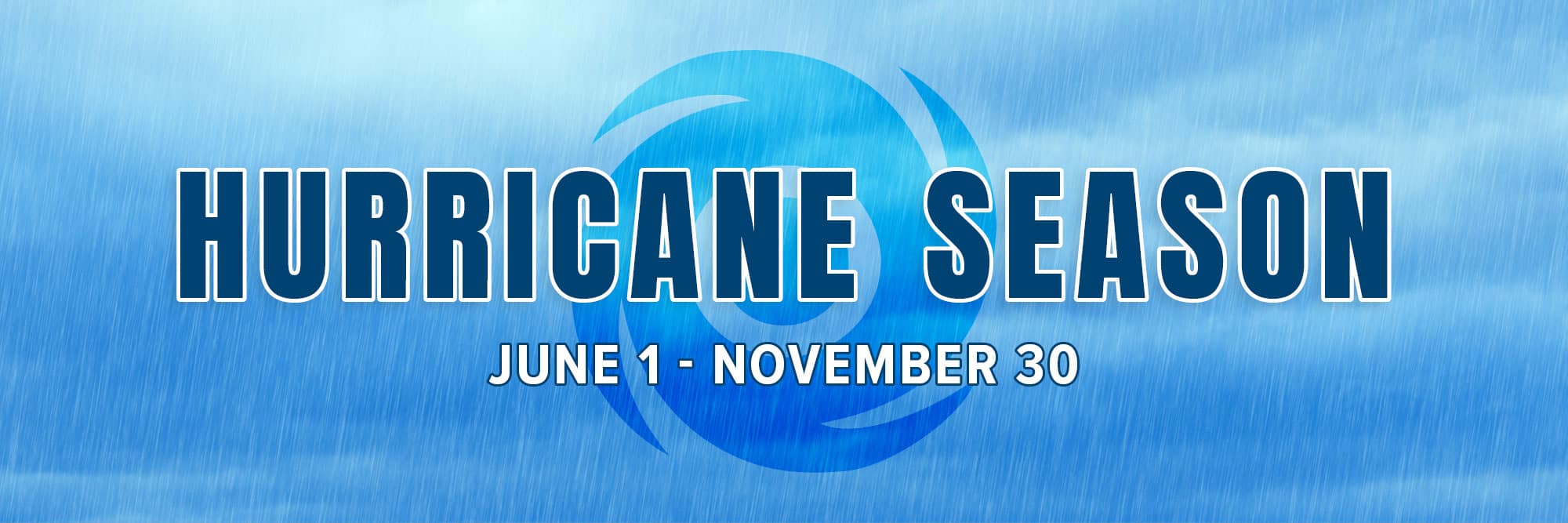Another active hurricane season is forecast. What can you do to prepare?

Is your FAMILY ready?
- Evacuation Plan: It’s likely that your community’s usual evacuation shelters are different this year. Check your county’s shelter information page for the latest updates.
- Communication Plan: When the phone lines go down, it’s important to have a communication plan in place to save time (and reduce anxiety!). To get started, check out this family communication plan template.
- Supplies: Have a week’s worth of bottled water, non-perishable foods, medicines, and other supplies ready. Toiletries, flashlights, batteries, first aid supplies, and a battery-powered radio should also be included in your portable kit in case you have to evacuate. Be sure to include plenty of pet supplies for your four-legged family members. Remember, pets are typically not permitted in public shelters.
- Health: Be sure to have supplies on hand to protect yourself (and others) from COVID-19 and other infectious diseases. Although mask and social distancing requirements have been lifted, there is always the possibility that these requirements could be reinstated in certain locales or specific shelters. CDC recommendations call for an ample supply of hand sanitizer, soap, and two cloth face coverings for each person.
Is your HOME ready?
- Storm Shutters: Are your storm shutters still in good condition or are repairs needed? If you are unable to board up windows or install storm shutters yourself, have you made arrangements for this to be completed by someone else?
- Yard: If you have a portable grill, picnic table, patio furniture, garbage cans, or lawn decorations that could become dangerous projectiles in high winds, clear a space in your garage or shed ahead of time to store them if needed. Large potted plants can be placed on their sides if you don’t have room to secure them inside.
- Prune and Trim: Weak tree limbs or branches too close to your house or roof can cause serious damage in a storm. Be sure to prune and trim shrubbery and trees at the start of and throughout hurricane season to help minimize possible damage. Inspect trees routinely to ensure they are healthy and remove excess Spanish moss from branches. If necessary, contact your utility company or a professional to trim limbs touching or close to power lines.
- Chemicals and Fuel: In preparing for the storm, store these items as high and securely as possible. Pool chemicals, insecticides. and that extra can of gas for the lawn mower can be especially dangerous if mixed with water. Even a couple inches of water on your garage floor can cause significant damage, especially when contaminated with toxins.
Is your CAR ready?
- Disaster Kit: Besides routine maintenance and keeping the gas tank close to full, stock up on extras for your disaster kit. Even if you have a roadside service firm, it may take them a while to reach you. Consider keeping on hand these items: road flares, flashlight (with extra batteries), booster cables, aerosol tire inflator, and duct tape (of course!). Always keep a car charger in your auto for your mobile phone.
- Map Route: Know your local evacuation route and keep a list of up-to-date phone numbers and addresses for area shelters or hotels. Instead of relying only on your cell phone, include other important phone numbers and email addresses: relatives, neighbors and friends; physicians; veterinarian; insurance agent; auto club and repair shop, and more.
- Insurance: Whenever possible, store your vehicles securely in a garage with a reinforced door. If your vehicle sustains storm-related damage, such as a falling tree or flooding, the comprehensive coverage portion of your auto policy will apply. Along with your auto insurance policy, be sure to keep copies of your current registration and service records.
Is your BOAT ready?
- Storm Plan: Most importantly, before storm season develop a plan to protect your watercraft. Whether your boat is small enough to fit in your garage or too large to haul on a trailer, you should prepare a reliable and practical storm plan. Storm surge is always a risk, but if the strongest winds arrive at high tide, the unthinkable can happen in a matter of seconds. Contact local marinas and storm facilities now regarding their capacity to secure your craft. Be sure to ask about their CAT rating – can the facility withstand the storm?
- Checklist: Make a checklist ahead of time to be sure you don’t miss a step in preparing your boat for a storm. If your craft is housed at a marina, be clear exactly which responsibilities are yours and which duties are the marina’s. A watercraft policy should be at the top of your checklist. Discuss coverage options with your insurance agent to be sure you have obtained and understand the protection you need.
- Fenders and Sails: Boating enthusiasts usually agree that when it comes to fenders, more are better. Because even small dents can be costly to repair, fenders are a simple and worthwhile investment that can minimize the damage to your vessel during a storm. If your boat has sails, remove the canvas, then stow securely. Keep a cordless drill handy for quickly removing the canvas frames.
- Trailer: If your storm plan includes hauling your boat to a safe place, routinely check your trailer tires and be sure your vehicle is up to the task. Plan to move your boat at least 72 hours before the hurricane (or tropical storm) is scheduled to hit the area.
- Secure Gear: Be sure to stow seat cushions or any loose items safely below deck. Anything that cannot be removed from the deck should be lashed down as securely as possible. Also, if the boat is being moved to dry storage, turn off the electrical system and/or remove the battery to help avoid possible fire damage.